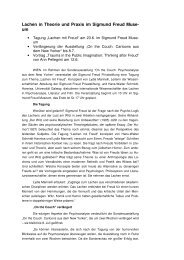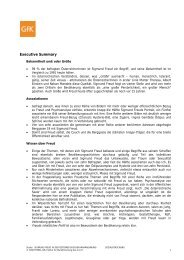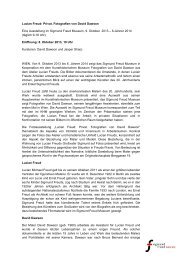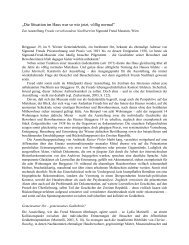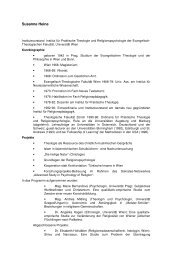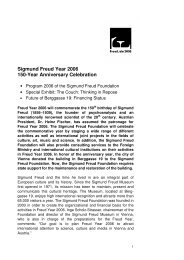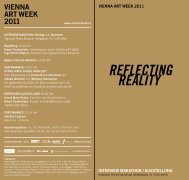Sigmund Freud-Museum | Newsletter - Sigmund Freud Museum Wien
Sigmund Freud-Museum | Newsletter - Sigmund Freud Museum Wien
Sigmund Freud-Museum | Newsletter - Sigmund Freud Museum Wien
You also want an ePaper? Increase the reach of your titles
YUMPU automatically turns print PDFs into web optimized ePapers that Google loves.
clearly points to a thing that is signified, and understanding is less likely to proceed through analysis<br />
than by navigation through virtual space.<br />
Appropriable theories, ideas that capture the imagination of the culture at large, tend to be those with<br />
which people can become actively involved. They tend to be theories that can be “played” with. So<br />
one way to think about the social appropriability of a given theory is to ask whether it is accompanied<br />
by its own objects-to-think-with that can help it move out beyond intellectual circles.<br />
For example, the popular appropriation of <strong>Freud</strong>ian theory had little to do with scientific<br />
demonstrations of its validity. <strong>Freud</strong>ian theory passed into the popular culture because it offered robust<br />
and down-to-earth objects-to-think-with. The objects were not physical but almost tangible ideas such<br />
as dreams and slips of the tongue. People were able to play with such <strong>Freud</strong>ian “objects.” They<br />
became used to looking for them and manipulating them, both seriously and not so seriously. And as<br />
they did so, the idea that slips and dreams betray an unconscious started to feel natural.<br />
In <strong>Freud</strong>’s work, dreams and slips of the tongue carried the theory. Today, life on the computer screen<br />
carries theory. People decide that they want to interact with others on a computer network. They get an<br />
account on a commercial service. They think that this will provide them with new access to people and<br />
information and of course it does. But it does more. When they log on, they may find themselves<br />
playing multiple roles; they may find themselves playing characters of the opposite sex. In this way<br />
they are swept up by experiences that enable them to explore previously unexamined aspects of their<br />
sexuality or that challenge their ideas about a unitary self. The instrumental computer, the computer<br />
that does things for us has another side. It is also a subjective computer that does things to us – to our<br />
view of our relationships, to our ways of looking at our minds and ourselves.<br />
Within the psychoanalytic tradition, many “schools” have departed from a unitary view of identity,<br />
among these the Jungian, object-relations, and Lacanian. In different ways, each of these groups of<br />
analysts was banished from the ranks of orthodox <strong>Freud</strong>ians for making such suggestions, or somehow<br />
relegated to the margins. As America became the center of psychoanalytic politics in the mid-twentieth<br />
century, ideas about a robust executive ego moved into the psychoanalytic mainstream.<br />
These days, the pendulum has swung away from any complacent view of a unitary self. Through the<br />
fragmented selves presented by patients and through theories that stress the decentered subject,<br />
contemporary social and psychological thinkers are confronting what has been left out of theories of<br />
the unitary self. Online experiences with “parallel lives” are part of the significant cultural context that<br />
supports new ways of theorizing about nonpathological, indeed healthy, multiple selves.<br />
V. Relational Artifacts:<br />
A Companion Species?<br />
In Steven Spielberg’s movie, AI: Artificial Intelligence, scientists build a humanoid robot boy, David,<br />
who is programmed to love. David expresses this love to a woman who has adopted him as her child.<br />
In the discussion that followed the release of the film, emphasis usually fell on the question whether<br />
such a robot could really be developed. People thereby passed over a deeper question, one that<br />
historically has contributed to our fascination with the computer’s burgeoning capabilities. That<br />
question concerns not what computers can do or what computers will be like in the future, but rather,<br />
what we will be like. What kinds of people are we becoming as we develop more and more intimate<br />
relationships with machines?<br />
In this context, the pressing issue in A.I. is not the potential “reality” of a non-biological son, but rather<br />
that faced by his adoptive mother – a biological woman whose response to a machine that asks for her<br />
nurturance is the desire to nurture it; whose response to a non-biological creature who reaches out to<br />
her is to feel attachment, horror, love, and confusion.<br />
The questions faced by the mother in A.I. include “What kind of relationship is it appropriate,<br />
desirable, imaginable to have with a machine?” and “What is a relationship?” Although artificial<br />
intelligence research has not come close to creating a robot such as Spielberg’s David, these<br />
questions have become current, even urgent.<br />
Today, we are faced with relational artifacts to which people respond in ways that have much in<br />
common with the mother in A.I. These artifacts are not perfect human replicas as was David, but they<br />
are able to push certain emotional buttons (think of them perhaps as evolutionary buttons). When a<br />
robotic creature makes eye contact, follows your gaze, and gestures towards you, you are provoked to



